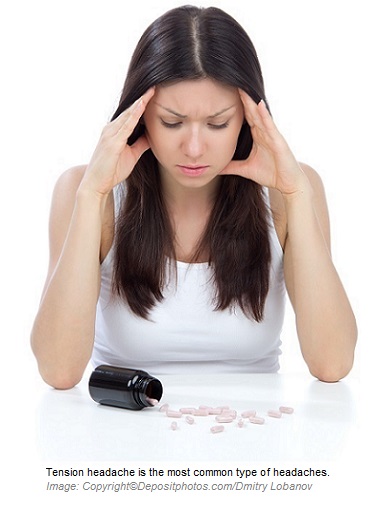 from the front or more commonly back of the head and increases gradually in intensity. It is described as a steady, squeezing, dull and non-throbbing pain. The patient feels pressure, tension, and tightness in the head. Headache is caused by continuous contractions of the muscles of the neck and scalp.
from the front or more commonly back of the head and increases gradually in intensity. It is described as a steady, squeezing, dull and non-throbbing pain. The patient feels pressure, tension, and tightness in the head. Headache is caused by continuous contractions of the muscles of the neck and scalp.
Contrary to migraine, tension headache is not usually associated with nauseous feeling and sensitivity to light and sound. It may last for days. Tension headache must be differentiated from migraine and cluster headaches.
Potential triggering factors:
- Stress.
- Sleep deprivation.
- Dehydration.
- Withdrawing from caffeine.
- Skipping meals or snacks.
- Eyestrain.
- Poor posture.
- Fatigue and tiredness.
- Magnesium deficiency.
- Premenstrual syndrome.
- Having sex (coital headache).
- Monosodium Glutamate (MSG).
Nutritional Support:
Restricted Foods:
- Processed foods.
- Additives.
- Preservatives.
- Grapefruit and garlic. They may lower blood pressure, prompting headache.
- Alcohol.
- Very cold foods or drinks, for example, ice cream (Ice Cream Headache).
Recommended Foods:
- Small frequent meals. Skipping meals and leaving long gaps between meals lower blood sugar, which may trigger tension headache.
- Whole grains.
- Water: Drinking at least 2 liters a day keeps the body fully hydrated, preventing tension headache.
- Green leafy vegetables.
- Legumes.
Recommended Supplements:
- Magnesium: 200 – 400 mg a day.
- Melatonin: 3 – 6 mg a day.
- 5-HTP: 50 – 100 mg a day.
- Chamomile: as a tea 3 – 4 times a day, as a tablet or capsule 2 – 3 a day, or as a tincture 5 ml 3 times a day .It has calming effect and should be taken between meals.
- Passion Flower: as a tea 1 – 2 grams 3 times a day, as a tablet or capsule 4 – 8 grams a day, or as a tincture 5 – 10 ml 3 – 4 times a day. Passion flower promotes muscle relaxation.
- French Maritime Pine Bark Extract: 100 – 200 mg a day.
- White Willow Bark: 60 – 120 mg a day. It contains salicin, from which salicylic acid is derived and has a pain alleviating effect.
Recommended Therapeutic Stretches:
Therapeutic stretches are recommended on a regular basis. They relax muscles and release muscle tightness. It is suggested that you learn to do them by yourself (active stretches), or someone else could perform them on you (passive stretches):
- Flexion stretch of the neck.
- Extension stretch of the neck.
- Right lateral flexion stretch of the neck.
- Left lateral flexion stretch of the neck.
- Right rotational stretch of the neck.
- Left rotational stretch of the neck.
- Scalene stretch.
- Upper back myofascial release using foam roller.
- Massage of the muscles of the neck and upper back.

